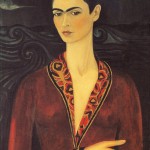Frida Kahlo’s honest, often bizarre, self-portraits reflect a beauty beyond the physical– an impishness in the wide eyes, a small smirk teasing at the corners of her mouth. In her renderings, her cheeks are always heavily rouged, and exotic flowers adorn her raven hair. Self-Portrait in a Velvet Dress uses the contrast of light — Kahlo’s glowing skin — and dark– the black background, and in doing so, this painting not only communicates the subject’s outward beauty. It also points to an unspoken turmoil inside of the painter: as dark as the night sky and as deep as rolling sea.
Much of Kahlo’s life was characterized by immense pain resulting from a lifelong battle with polio, and a bus accident in 1925 that left her crippled at the age of eighteen. It was in those lonely evenings, laid up in her hospital bed when Kahlo began to paint herself, as she was the only subject matter she had.
Frida Kahlo was born Magdalena Carmen Frieda Kahlo y Calderón on July 6, 1907 in Mexico to Matilde Calderón and Guillermo Kahlo. She was a middle child of four, and she spent her childhood in Coyoacán, Mexico City in la Casa Azul, the Blue House. Though she was born in Mexico and stands today as a pioneer of Mexican folk art, Kahlo was actually ethnically half-European. “Frieda” was the original Hungarian spelling of her name, but she came to use the Spanish spelling, “Frida” furthering her carefully crafted persona. Her father, Wilhelm— he only later changed his name to Guillermo— was Hungarian, and her mother, Matilde was of Spanish, and indigenous, descent.
This work stands out among the rest of Kahlo’s collection for its references to European art and a European standard of beauty. The woman portrayed here is only a version of the artist. Her hand is placed delicately on her arm; her white neck, elongated. The piece conjures images of Da Vinci’s Mona Lisa in the subject’s knowing smile and Van Gogh’s Starry Night with the rolling waves in the background. These works in and of themselves were fitting inspirations, as both were, at their debuts, ill-received, misunderstood and wholly under-appreciated. At the time, critics questioned Mona Lisa’s smile, and scoffed at Van Gogh’s celestial cityscapes. Kahlo herself never saw much recognition in her lifetime, as she spent most of her career being tied to another artist, her husband, Diego Rivera.
The audience could interpret this use of the European style as a nod to the well-respected European greats like Da Vinci and Van Gogh, or one could interpret this as Kahlo’s attempt to thumb her nose at these painters. Take the exaggerated features of this work; one could suppose that the woman’s neck is too stretched, her tempting dress to too red, the cut of it too low. Consider these features, and this here Self-Portrait in a Velvet Dress becomes a caricature-Kahlo and is no longer the genuine artifact.
This mockery is Kahlo’s rejection of the European standard, a rejection of the culture, and it acts as the artist’s way of further embracing her Mexican culture and identity. It would not be too hard to imagine, given that the artist was a notorious firecracker, a rebel and a patriot to the very end. “I was born a bitch,” she was once quoted for saying, “I was born a painter.”
With this piece, Frida Kahlo bucked tradition using a subtly that only skilled artists possess. Self-Portrait in a Velvet Dress draws the audience in with its unintimidating size, holds them in a vice grip and fascinates them with its beauty. But, in truth, Kahlo was painting more than just a pretty picture. Kahlo’s Velvet offers a shining example of her own talent and versatility while never abandoning her signature style. Chiefly, it demonstrates the artist’s complexity and her ability to critically examine her cultural identity and herself, as only she could.
AJD
Works Cited
- “Frida Kahlo Biography.” Frida Kahlo Biography. N.p., 2015. Web. 16 July 2015.
- “Frida Kahlo Biography.” Bio.com. A&E Networks Television, n.d. Web. 17 July 2015.
- “Frida Kahlo: Her Photos.” 9788492480753:. Editorial RM, n.d. Web. 17 July 2015
